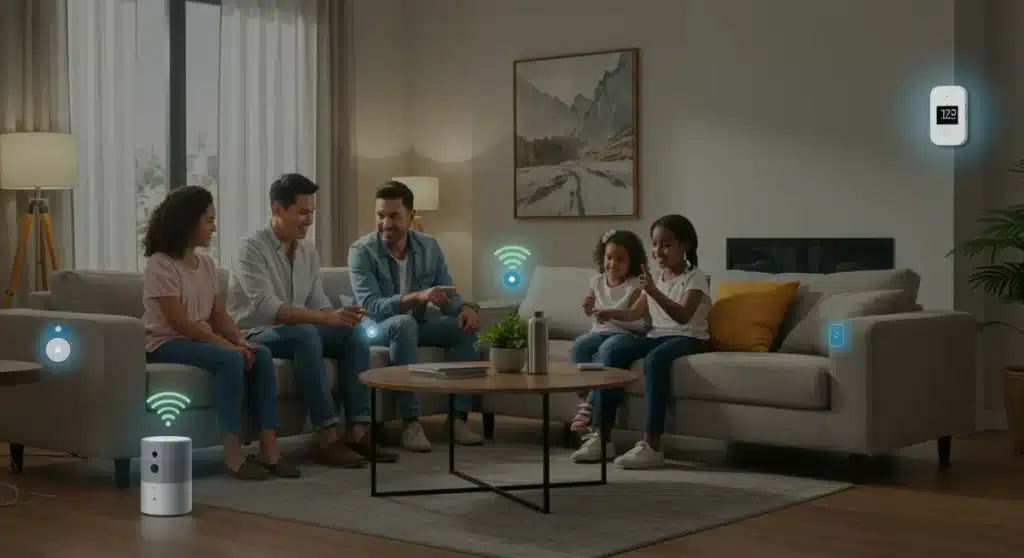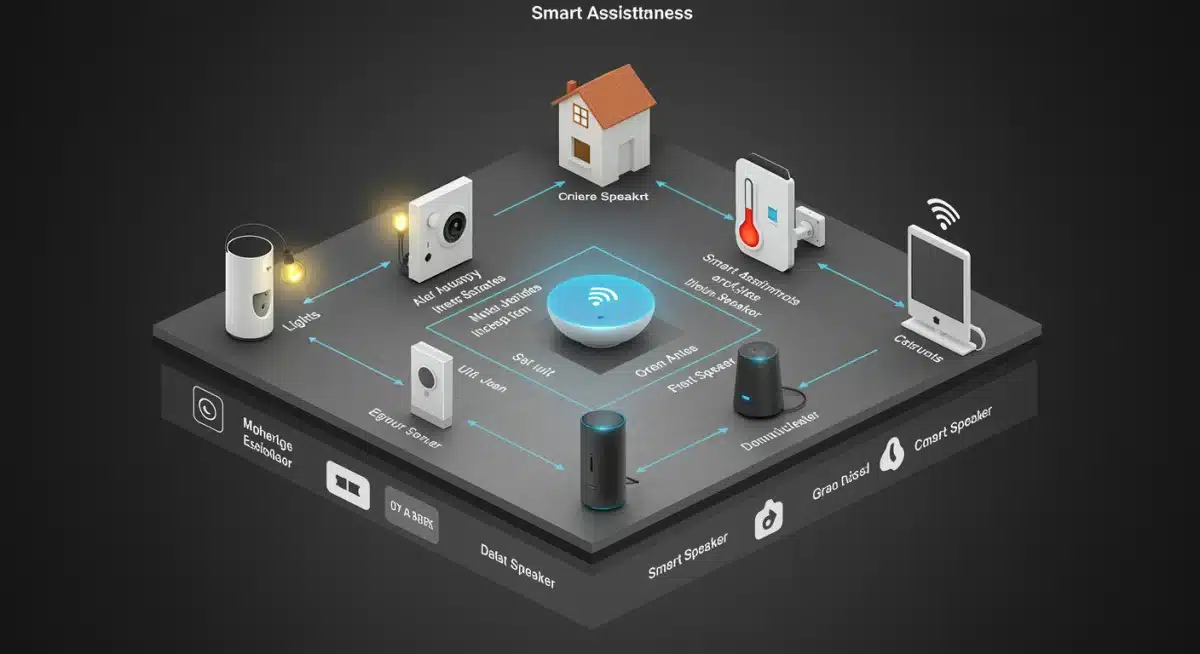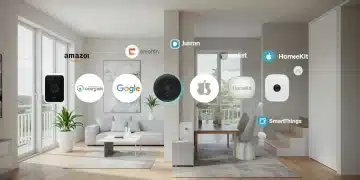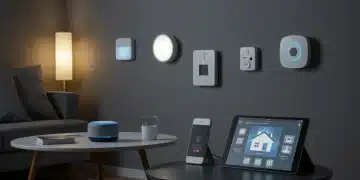Smart Home Voice Assistants: Choosing the Best in 2025 US

Smart Home Voice Assistants: Choosing the Best Ecosystem for Your US Home in 2025 (COMPARISON/ANALYSIS) hinges on evaluating current market leaders like Amazon Alexa, Google Assistant, and Apple HomeKit, considering their device compatibility, privacy features, and long-term ecosystem viability for seamless integration.
The landscape of Smart Home Voice Assistants: Choosing the Best Ecosystem for Your US Home in 2025 (COMPARISON/ANALYSIS) is rapidly evolving, presenting both exciting opportunities and complex decisions for consumers. As artificial intelligence becomes more sophisticated and device integration more seamless, selecting the right voice assistant ecosystem is crucial for maximizing convenience, security, and energy efficiency in your household.
The Current State of Smart Home Voice Assistants in 2025
As of late 2024, the smart home market in the US continues its robust expansion, with voice assistants serving as the central nervous system for countless connected devices. Amazon Alexa, Google Assistant, and Apple HomeKit remain the dominant players, each vying for supremacy through enhanced AI, broader device compatibility, and improved privacy features. Recent developments indicate a stronger push towards interoperability, though proprietary ecosystems still present significant advantages for users committed to a single brand.
Reports from leading tech analysts highlight a growing consumer demand for more intuitive and proactive AI, moving beyond simple command-and-response interactions. The integration of generative AI capabilities into voice assistants is a key trend emerging in 2025, promising more natural conversations and predictive assistance. This shift impacts how users interact with their homes and how effectively these systems can anticipate needs before being explicitly asked.
Key Market Players and Their Recent Updates
The competition among the top three — Amazon, Google, and Apple — has intensified, with each platform rolling out significant updates in the past year. Amazon’s Alexa has focused on expanding its Matter compatibility and enhancing its ‘Local Voice Control’ features, allowing certain commands to be processed on-device for faster responses and improved privacy. Google Assistant, meanwhile, is leveraging its advanced AI research to offer more personalized routines and improved contextual understanding, especially within its Android ecosystem.
- Amazon Alexa: Enhanced Matter support, local voice processing, new generative AI features for conversational interactions.
- Google Assistant: Deeper integration with Google’s AI models, more personalized routines, improved contextual awareness across devices.
- Apple HomeKit: Stronger emphasis on privacy and security, expanded support for Matter, and refined user experience within the Apple ecosystem.
Understanding Ecosystem Compatibility: A Crucial Factor
One of the most critical considerations when choosing a smart home voice assistant is its compatibility with existing and future smart devices. An ecosystem’s strength often lies in the breadth and depth of its device support. In 2025, the Matter standard is playing an increasingly vital role in bridging the gaps between different platforms, aiming to simplify the setup and control of smart home devices regardless of their manufacturer or the voice assistant used.
However, despite Matter’s promise, native integration often provides the most seamless and robust experience. For instance, an Amazon Echo device will typically offer a more integrated experience with Ring security cameras (an Amazon subsidiary) than with a Google Nest device. Users must carefully assess their current smart device inventory and future purchasing plans to align with an ecosystem that offers the best native and Matter-enabled compatibility.
The Role of Matter in 2025 Smart Homes
Matter, the new open-source connectivity standard, has gained significant traction, promising to unify the smart home experience. As of early 2025, most major smart home device manufacturers and voice assistant platforms have committed to or already implemented Matter support. This means that a device certified with Matter should theoretically work seamlessly with any Matter-enabled voice assistant, whether it’s Alexa, Google Assistant, or HomeKit.
- Simplified Setup: Matter aims to make device pairing much simpler, eliminating complex network configurations.
- Increased Choice: Consumers are no longer tethered to one ecosystem due to device limitations.
- Future-Proofing: Devices with Matter support are more likely to remain compatible with future smart home innovations.
Privacy and Security: A Growing Concern
As smart home voice assistants become more integrated into daily life, concerns about privacy and data security are escalating. In 2025, consumers are more aware than ever of the data collected by these devices and how it’s used. Each major platform has responded with varying degrees of transparency and control mechanisms, but fundamental differences persist.
Apple HomeKit generally maintains the strongest reputation for privacy, with much of its processing occurring on-device and a clear stance on data minimization. Amazon and Google have also introduced more granular privacy controls, allowing users to review and delete voice recordings and opt out of certain data collection practices. However, their business models still rely heavily on data for personalized services and advertising, which can be a point of contention for privacy-conscious users. Users must review each platform’s privacy policies and available settings to make an informed decision based on their comfort level.

User Experience and AI Capabilities
The overall user experience (UX) and the sophistication of the AI powering the voice assistant are paramount. A truly intelligent assistant should understand natural language, learn user preferences over time, and execute complex multi-step commands efficiently. In 2025, the integration of large language models (LLMs) into these assistants is beginning to redefine what’s possible, moving beyond simple keyword recognition to more nuanced conversational interactions.
Google Assistant, backed by Google’s extensive AI research, often leads in natural language processing and contextual understanding. Alexa has made significant strides, particularly with its ‘Adaptive Listening’ and personalized routines. HomeKit, while perhaps less conversational than its rivals, excels in its tight integration with iOS and macOS, offering a consistent and reliable experience for Apple users. Evaluating an assistant’s ability to handle complex queries, manage routines, and proactively offer assistance is key.
Generative AI and Future Interactions
The advent of generative AI is poised to revolutionize smart home interactions. Instead of rigid commands, users can expect more fluid conversations, where the assistant anticipates needs and offers creative solutions. Imagine asking your assistant to ‘set the mood for a cozy evening’ and having it intelligently adjust lighting, temperature, and even music, without needing precise instructions for each device.
- Natural Conversations: Assistants will understand context and intent more effectively, reducing the need for specific phrasing.
- Proactive Assistance: AI will learn routines and preferences to offer help before being explicitly asked.
- Personalized Environments: The ability to create dynamic, personalized home environments based on mood or activity.
Cost and Device Ecosystem Investment
The financial investment required to build out a smart home ecosystem is a significant factor. While the initial cost of a smart speaker might be low, the cumulative expense of compatible smart lights, thermostats, security cameras, and other devices can quickly add up. Each ecosystem has its own range of first-party devices and a vast array of third-party options, with varying price points and feature sets.
Amazon’s Alexa ecosystem often boasts the widest range of affordable devices, making it an attractive entry point for many. Google Assistant devices are also competitive, with a strong focus on integration with Google’s broader services. Apple HomeKit devices, while fewer in number and often at a premium price point, typically offer superior build quality and tighter integration within the Apple ecosystem. Consumers should consider not just the cost of the voice assistant hardware, but the total cost of ownership for their desired suite of smart home functionalities.
Installation, Setup, and Ongoing Maintenance
The ease of installation and setup, along with the ongoing maintenance requirements, significantly impact the user experience. A complex setup process can deter even tech-savvy users, while frequent troubleshooting or compatibility issues can lead to frustration. In 2025, platforms are increasingly prioritizing user-friendly onboarding and reliable performance.
Amazon and Google have streamlined their setup processes significantly, often requiring just a few steps through their respective apps. Apple HomeKit is renowned for its straightforward setup, especially for devices designed with HomeKit in mind, leveraging the existing Apple ID for seamless integration. Ongoing maintenance typically involves software updates, which are usually automatic, but users should also consider the availability of customer support and online resources for troubleshooting any issues that arise. Reliability and a strong support network are key for a hassle-free smart home experience.
| Key Aspect | Brief Description |
|---|---|
| Ecosystem Compatibility | Assessing device support and native integration, with Matter standard bridging platforms. |
| Privacy & Security | Evaluating data collection, on-device processing, and user controls for personal information. |
| AI & User Experience | Analyzing natural language understanding, generative AI integration, and overall ease of interaction. |
| Cost & Investment | Considering initial hardware costs and long-term expenses for compatible smart home devices. |
Frequently Asked Questions About Smart Home Voice Assistants
Apple HomeKit generally leads in privacy, emphasizing on-device processing and robust data protection. While Amazon Alexa and Google Assistant have improved privacy controls, HomeKit’s architecture is designed with user data security as a core principle, offering greater peace of mind for privacy-conscious users.
Matter significantly improves interoperability, allowing devices from different brands to work together more easily. This means your choice of voice assistant might become less about device compatibility and more about the assistant’s AI capabilities, user interface, and specific features, as Matter bridges many previous gaps.
Yes, generative AI is increasingly being integrated into smart home voice assistants in 2025. Platforms like Amazon Alexa and Google Assistant are leveraging LLMs to offer more natural, conversational interactions, proactive suggestions, and the ability to understand and execute complex, multi-step commands more intuitively than ever before.
Amazon’s Alexa ecosystem often provides the most cost-effective entry point. It features a wide range of affordable smart speakers and a vast selection of third-party compatible devices at various price points, making it accessible for users on a budget to build out their smart home.
Yes, it is possible to use multiple voice assistants, especially with the rise of Matter-compatible devices. However, managing different ecosystems can be complex and may not offer the seamless integration of a single, unified system. Many users choose one primary assistant for core functions.
What This Means
The rapid evolution of Smart Home Voice Assistants in 2025 signals a pivotal moment for consumer choice and technological integration. The ongoing developments in generative AI, coupled with the increasing adoption of the Matter standard, are fundamentally reshaping how US households interact with their smart environments. Consumers are now empowered with more options for interoperability, but must also navigate heightened privacy concerns and the nuances of each platform’s AI capabilities. This trend indicates a future where smart homes are not just connected, but truly intelligent and responsive to individual needs, demanding careful consideration of ecosystem choice for optimal long-term satisfaction.





